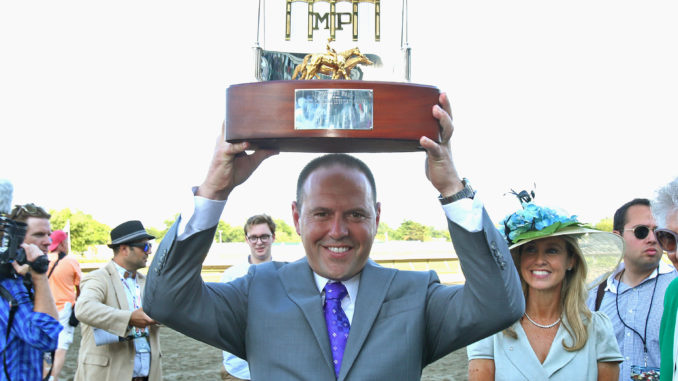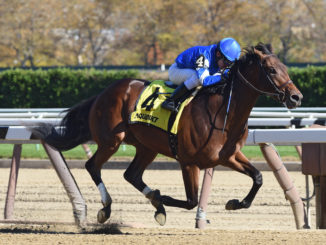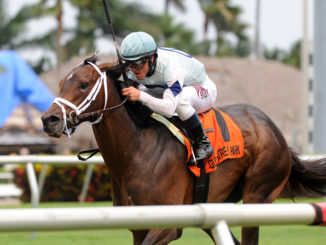
by Jim Mulvihill
Chad Brown’s dominance is well-documented, and the numbers speak for themselves.
At the Saratoga Race Course meeting that ended Monday, he led all trainers with 41 wins, nearly double the total of his closest rival, the former and longtime Saratoga standard-bearer Todd Pletcher (21 wins). Meanwhile, Brown’s starters hit the board 62.9% of the time, 10 points higher than anyone else in the Top 10.
If those numbers speak for themselves, though, there is another set of numbers that is screaming into the ether because they are even more impressive yet not nearly as well publicized. The traditional win percentage, of course, reflects wins from starts. But there has likely never been a trainer at the highest level of U.S. racing who runs as many of his own horses against one another. It’s not unusual for Brown to get a W while taking two Ls at the same time, suppressing his own win percentage. A more telling indication of Brown’s influence is to examine the percentage of races he’s represented in that he wins.
At Saratoga, Brown’s overall win clip was 23%, the result of 41 wins from 178 starts. It’s a gaudy number but hardly an outlier. Others in the Top 20 with what I would consider a meaningful sample size and similar results included Jason Servis (25%, 13-for-53) and Graham Motion (23%, 9-for-40).
Brown, however, was far more likely than any of them to be the winning trainer in his races, and practically guaranteed to have an impact on the mutuels. That’s because there were almost 50 races at Saratoga with multiple Brown entrants, inevitably resulting in a loss (or even two or three losses) in many of the same races he won. From the 129 races he participated in, Brown won 31.8% of them and ran in the money an astounding 86.8% of the time.
Since only one horse can win a race we will refer to the larger number as the barn’s “true” win percentage. After all, aside from the remote possibility of a same-trainer dead heat (something I have actually seen in person, by Cole Norman at Lone Star in the early aughts!), there can be no expectation of winning a race more than once if you enter multiple runners.
On the year, through Labor Day racing (January 1-September 2), Brown’s overall traditional win percentage is an eye-popping 27.1%, with 153 wins from 563 starts. But when you take out 125 horses that finished behind one of their stablemates, Brown’s “true” win percentage is on a complete other level, at 34.9% (153-for-438). If Chad Brown is in a race he will factor in the trifecta more than four out of every five times (81%).
That Brown can comfortably employ this strategy of regularly saddling multiple horses in a race and still post a high win percentage is an unprecedented flex of power. We live in an era when most trainers do everything they can to post the highest clip possible for all the world to see. It’s assumed, and probably accurate, that most owners gravitate to the conditioners with the top stats. The same obsession with win percentage also holds some blame for a dwindling average of starts per horse. The thinking goes that nobody wants to race a good horse into shape anymore, choosing instead to train harder in the morning and only run in the afternoon when the horse is fit to put forth its best effort. Similarly, many trainers and owners feel disincentivized from taking shots in tough spots because they’d rather be a short price in an easier race and keep those numbers up.
None of this seems to bother Brown, though. If anything, perhaps there is a side benefit to keeping his batting average lower, so as not to arouse more of the jealousy and scrutiny that always accompanies success in Thoroughbred racing. Brown’s owners understand the true win percentage and don’t mind being one of three saddled by the same guy in a graded stakes race, as you’re better off with him than against him.
Horseplayers can find the situation maddening to parse, as nearly every Brown entrant has the ability to win, and rarely are they part of entries for wagering purposes. The longer-priced ones typically aren’t rabbits or longshots; they’re in that spot because it’s where they belong. Every horse in the barn gets their chance to be the best they can be. A bettor can’t confidently toss any of them.
For most trainers anything that would drop their published win percentage by several points would have a devastating effect on their business. The difference in perception between a 15% trainer and a 22% trainer is the difference between mediocrity and super stardom. Meanwhile, for Brown, the difference between a 27% trainer and a “true” 35% trainer is just the difference between the Hall of Fame and the Greatest of All Time.
Top 5 Trainers by “True” Win%
TRAINER RACES WINS %
Brown 438 153 34.9
Navarro 492 158 32.1
Servis, Ja. 348 106 30.4
Kreiser 322 98 30.4
Broberg 1,367 415 30.3
From 60 trainers w/ at least 275 races January 1-September 3




Interesting piece, Jim! Not knocking Chad in the least, but it seems to me that tossing out “extra” runners to come up with a “true win percentage ” makes no sense, since, in most cases, he has two advantages in those races: 1) he has more chances to win, and 2) he can put different types of runners in a race to virtually insure at least one of them runs well. From what I’ve seen, he won’t enter two horses that will duel on the front end, nor does he generally put two closers in a race together unless he can guarantee the pace with a third runner. I’d be more interested to see the percentage of all-Chad exactas in races where he had two runners and trifectas where he had three. He would still have the aforementioned pace setup advantage, but at least then you could say he might still have won with the second place horse had the first not been entered or with the third place horse had the top two not been in.